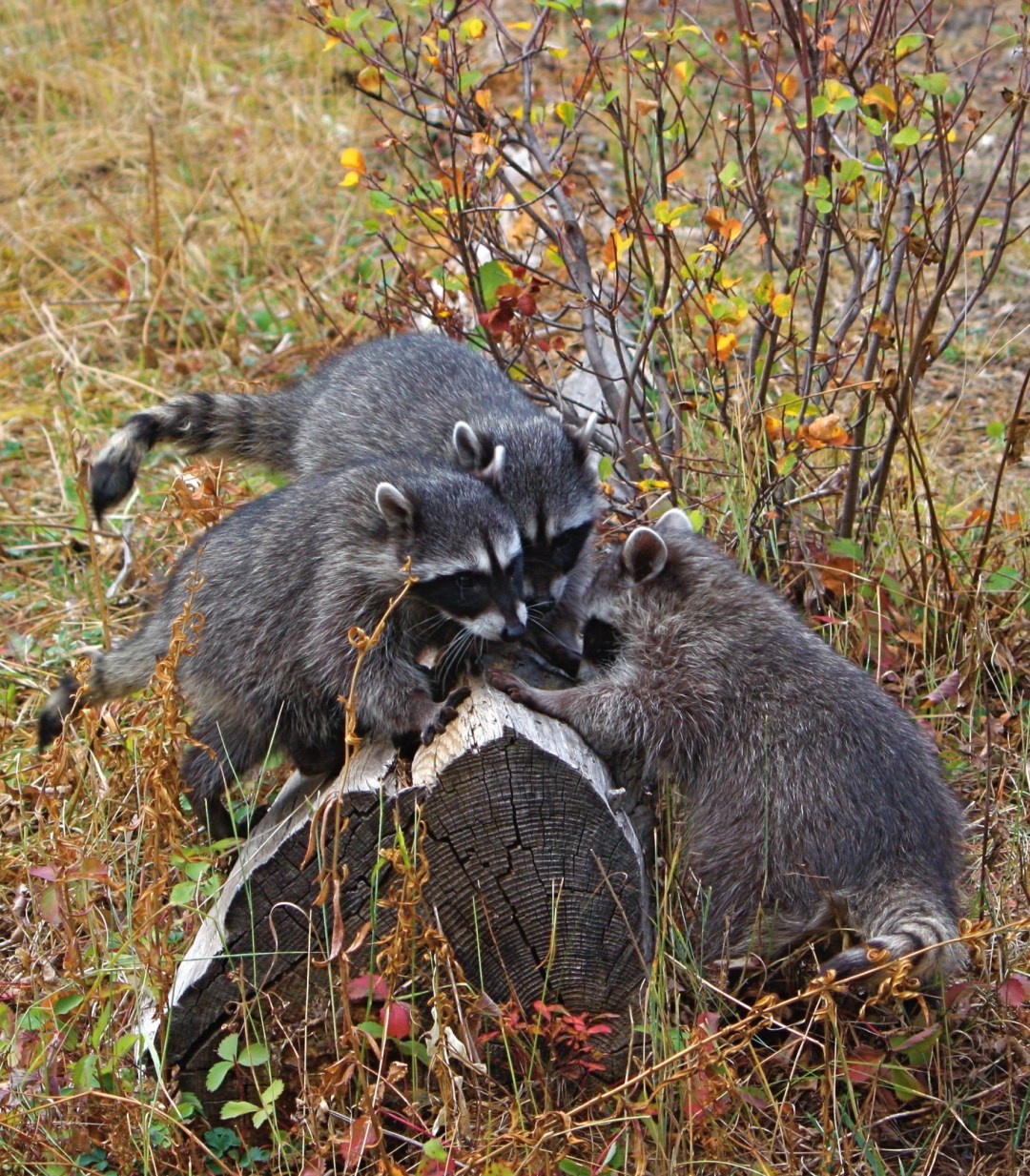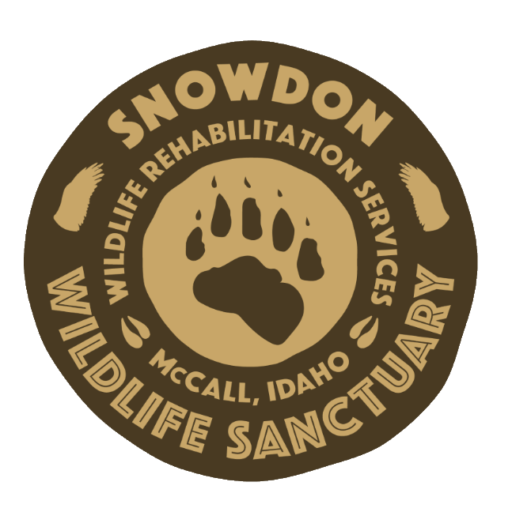
Each summer, Snowdon rescues any number of wild animal babies, and this year was no exception. Alyssa and her staff have had numerous orphans streaming through our clinic for treatment, including birds of all sorts, waterfowl, squirrels, skunks, bunnies, fawns, and perhaps the most heart-melting of all, baby raccoons! One summer as a friend and I were volunteering at Snowdon, we noticed there were three orphaned raccoons that were tucked away in the clinic. They needed multiple bottle feedings each day. As the hardworking Snowdon staff was typically overwhelmed with baby animal care during the summer months, we offered to help feed the little guys. I peered into a small kennel and saw three tiny gray and white things all huddled together sleeping. How utterly peaceful and adorable. When they heard the latch of the kennel door open, they sprang to life! All three babes came toddling out, making incredibly raucous screeching cries, and using their tiny little raccoon hands to grab out at anything that might become a handhold. They were perfect little miniature raccoons, so soft and yet so loud! We each gently grabbed one or two and proceeded to fumble around with some syringe tubes filled with warm milk replacer formula. The babies had not learned to use a nipple tip (and never would), so we just put this huge syringe tube in their mouths and slowly squeezed out the formula. Amazingly enough, those little babies unhinged and opened their jaws to grab that huge syringe tube, and we were off to the races. They squawked the whole time unless the milk was actually going down their throats, at which time the screeches turned more into gurgles. They all ended up with milk all over their faces and running down their tiny bodies, but that didn’t seem to matter. All they wanted were full bellies. One by one, when we achieved full belly status, the screeching stopped, we cleaned them off, and they toddled off to sleep in their cushy bedding. It would all be repeated in a few hours. Whew! But boy were those little masked faces and grabby hands cute.
As the little noise-pots grew, they demonstrated amazing climbing and clinging skills on the kennel door. When it was meal time, they would be all over that mesh door, clinging upside-down, sideways, and into any other position their little fingers could get them into. It was all noise, all movement, and all messy fun until those bellies were satisfied. One baby had an obvious case of mange on her tail, which was being treated every few weeks with the appropriate parasite medication. I think it was my second or third feeding when someone casually mentioned that I should be wearing gloves. Oh, right – my mistake. Mange is caused by tiny parasites that burrow into the skin and wreak havoc on one’s hair follicles. Surely once I washed my hands after handling those cute little raccoon rascals, the parasites would disappear down the drain. Not so! The night after my last ungloved feeding, I woke up in the middle of the night with my right hand on fire. I groggily reached over to my bed stand where I had a stash of various creams and oils, grabbed a bottle of peppermint/wintergreen oil, and slathered it on the hand. The next morning, I had a vague recollection of doing something with that oil, but I couldn’t quite remember until I smelled my hand. It felt great and smelled even better! The oil must have drowned the little mange mites. But the memories of that pain came back, and I now have a whole new perspective on what animals with mange go through. It is agonizing. No wonder infestations can kill entire colonies of squirrels and foxes! The pain and relentless burning can sap an animal’s immune system and cause horrible hair loss, leading to starvation and eventual death. Knowing that the baby raccoons at Snowdon had mange that was being successfully treated made me feel quite good about wildlife rehabilitation and the good work they can do.
As the baby raccoons outgrew their kennel and were able to climb well, they were transferred to a special raccoon enclosure. We helped stock the enclosure with tree branches to climb, fun things to do, and we even hung a little hammock for them to sleep in. Now we had to back off from human contact and let them become wild again. That was easier said than done because those creatures are just so cute. Their little busy fingers are always going, and they make these cute little chittering and purring sounds. We just enjoyed watching them play amongst themselves with no input from us. The best part was watching them eat the fruit, veggie, and dog kibble salads we made for them. Hearing them crunch grapes and watching the pure joy on their faces was priceless. They loved playing in the water, too. There’s a great video on Snowdon’s Facebook page of baby raccoons playing with the running water of a hose.
By September, the babies had grown into little adults, and the cute chittering was replaced with a little more growling and hissing, which is perfectly normal and just fine. Raccoons are pretty much defenseless in the wild except for their attitudes and growls and hisses. They need to intimidate to survive since they can’t really run fast or threaten anyone with sharp claws. Those little fingers are sure soft and cute, but they can’t be used in self-defense. All orphaned raccoons rehabilitated at Snowdon, including the two cuties Alyssa and crew have this summer, will exhibit the same behaviors as they grow and mature. Their hissy attitudes let us know when it is about the right time to release them back into the wild. What I didn’t know with that first trio, however, was exactly how to catch them and put them in transport crates. My friend and I volunteered to release the now-large and wild raccoons, and so one day we went into the raccoon enclosure with all kinds of confidence that this would be easy. Just throw their favorite foods into a crate and wait for them to stroll in. Uh, no, that’s not what happened. We tried everything we could think of to get them into the crates, but the little monkeys had other ideas. After my clumsy attempts flailing around and getting beat by those slippery little goons, I was finally able to barely grab one’s neck scruff and toss him into a crate, at which time he let out a growl that sounded like an adult cougar! Yikes. I soon got better at a more peaceful transfer when I was able to grab a young raccoon by her torso from behind. She just went limp and let me do that – no growling, no squirming. It was as if she said, “Well, why didn’t you just do that to begin with?” I have since learned that the torso grab is the best way to handle raccoons, so a few years later when faced with the same task of catching young raccoons for release, it went much more smoothly. I did get a few growls, a bite on the glove, and some loose bladder spray that conveniently went into hubby Jeff’s direction, but we caught those raccoons quickly and drama-free. Holy cow.
At both release sites, we chose areas near streams with lots of trees for the raccoons to climb for safety. Both sets of raccoons that I released acted the same while facing newfound freedom. They initially did not want to leave their kennels. One bold one would finally step out and immediately climb the kennel door, showing us once again their impressive gravity-defying skills. The others would follow eventually, all climbing up, over, and around their kennels. That actually made for some great photo ops. Slowly but surely, the little group of siblings would amble off, all the while smelling, touching, and examining anything they could explore. It must have been a sensory overload for these orphans to finally get this chance to be reintroduced to nature. I loved the way they stuck together. The second released pair found a slick-bark birch tree to climb, and my release partner, Snowdon Board of Directors member Debbie, and I had several silent moments of laughter as they each fell out of that tree twice! But those little raccoon fingers soon learned how to master birch bark, and we left the youngsters with a stockpile of food to snack on before we slowly retreated away. May their little bandit skills serve them well in the wildlife! May the raccoons currently in the care of Snowdon Wildlife Sanctuary enjoy a similar release experience in the near future. In other words, this story is to be continued.



